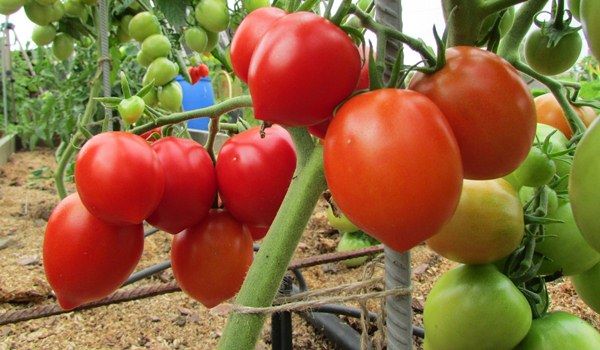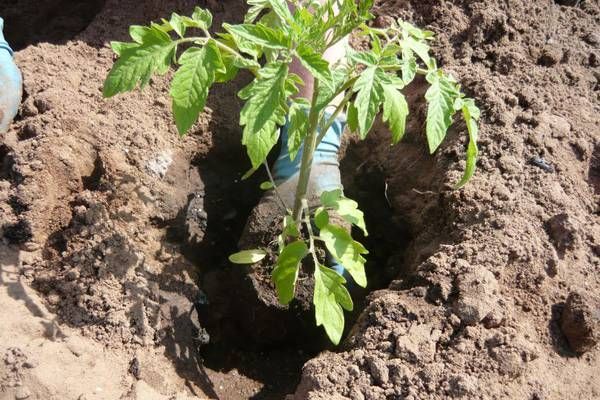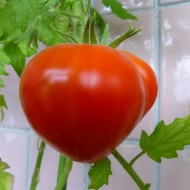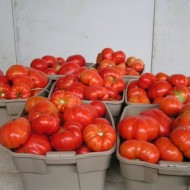We grow a large-fruited tomato variety Budenovka in the open field
Content
History and regions of cultivation
The hybrid variety was bred in 2001 by the State Agricultural Institute of Vegetable Crops. In 2002, the tomato was registered in the State Register of the Russian Federation. The culture is intended for regions with harsh climatic conditions, which is why the plant can be grown under film.

Video "Rules for planting tomatoes in the ground"
This video will show you how to plant tomatoes outdoors.
Characteristics of Tomato Budenovka
The hybrid belongs to the indeterminate varieties, that is, those that do not have an end point of growth. Thus, it is recommended to pinch the bushes.
Description of the bush
Given the indeterminate characteristics of the tomato, it must be tied to a support. The stem of the plant is thin, has a weak foliage. The foliage of the Budenovets tomato, as this variety is also popularly called, is quite wide, flat in shape. As a rule, 7-9 brushes are formed on one stem. On each of them 4–8 fruits are formed, the weight of which reaches 0.5 kg.
The root system of the hybrid variety is powerful and branched. During the growing season, the roots go 0.5 m deep into the ground.
The main qualities of the fruit
Tomatoes have a rounded, slightly elongated shape with a characteristic "spout". It is curious that the name of the variety is associated with the similarity of the fruit with the original headdress of the Red Army.
Tomatoes reach 15 cm in diameter, and the average weight is 0.5 kg. Sometimes the fruits weigh 0.7–0.8 kg. The pulp of a tomato is tender, soft, fleshy. The taste of the fruit is sweetish, with a slight sourness. Budenovka tomatoes are characterized by the presence of many seeds.
- Tomato variety Budenovka
Productivity and methods of consumption
The crop yield is high. The first harvest comes already 103-106 days after planting. Subject to compliance with all growing standards from 1 sq. m comes out 9 kg of tomatoes. The fruits are large and of high quality.
There are a lot of options for using in cooking. Most often, Budenovka tomatoes are consumed fresh, adding to salads, sandwiches, vegetable cuts. Soups, borscht, gravy are also made from tomatoes.
This type of tomato is preserved mainly in sliced form. In addition, tomato paste, sauces, juices are prepared for the winter. However, in the case of tomato juice, it should be borne in mind that the consistency of the drink will turn out to be quite thick.
Advantages and disadvantages of the variety
Budenovka is famous not only for its excellent taste.
- large-fruited;
- average ripening times;
- high yield rates;
- long fruiting period - up to 4 weeks;
- resistance to many fungal diseases;
- the ability to adapt to almost any weather conditions;
- unpretentious care.
- unsuitability for conservation as a whole, due to the large size of tomatoes;
- the inability to grow crops from seeds.
Features of planting and growing
The variety belongs to hybrids, therefore, it has certain cultivation characteristics.

Collection and storage of seeds
It is recommended to plant Budenovka with seedlings. For this, the seeds are pre-collected. In order for the planting material to be of high quality, you must follow these rules:
- Wait until the largest tomato ripens. At the same time, it should not be plucked from the bush.
- Extract the pulp from the tomato. Pour water over it and place in a warm place.
- After 5-7 days, the mass will turn sour, and the seeds will float to the surface.
- They should be washed and dried.
Soil preparation and sowing seeds
Sowing of seeds is carried out in the middle of spring. They must be sorted out beforehand. This is done using a saline solution into which the planting material is immersed. After a while, low-quality seeds will float up. Further, it is recommended to disinfect them in a manganese solution and soak in a growth stimulator. The soil must first be calcined in the oven and disinfected.
The seeds are deepened into the soil by 2-3 cm. For faster emergence of seedlings, containers with future seedlings are covered with cling film.
Growing and transplanting seedlings
Seedlings are transplanted into open ground after the first brush has formed on it. It is recommended to plant a crop on fertile soil. Zucchini, carrots, and parsley will be excellent predecessors.
The bushes are planted at intervals of 40 cm, and a distance of 0.5 m should be left between the rows.
At first, the plant needs to be watered twice a week. After a period of flowering and the formation of ovaries, watering is reduced.
Methods for increasing yields
Experienced gardeners claim that the yield level of tomatoes can be adjusted. To do this, it is important to comply with the basic growing conditions:
- Regular watering. It should be done once a week. In any case, it is worth focusing on the state of the topsoil.
- The first feeding is carried out during flowering. Further - during the formation of ovaries. The best top dressing for tomatoes will be potash and phosphorus compounds, as well as compost.
- Regular removal of stepchildren from the leaves, on which quite a lot of nutrients are spent.

Disease and pest resistance
The variety is resistant to many fungal diseases, including late blight. As a preventive measure, gardeners often spray crops with fungicide solutions.
Reviews of gardeners about the Budenovka variety
Reviews of gardeners finally convince: Budenovka is an excellent variety of tomatoes.
“We are very pleased with the Budenovka variety. We have been growing for about three years. During this time, there were no problems. The fruits are very large and juicy. An excellent option for summer salads and winter preservation. "
“We did not have a relationship with Budenovka right away. The bush grew very weak, short, with a thin stem. Despite this, the harvest exceeded all expectations. The tomatoes are large and sweet. The lethargy of the bush was probably associated with improper care. Therefore, if all the rules of cultivation are observed, a delicious harvest of tomatoes is guaranteed! ".
The Budenovka variety is known to many gardeners. The culture is highly adaptable to weather conditions and does not require much maintenance. The main thing is to observe the watering regime and not leave the bushes without top dressing.



